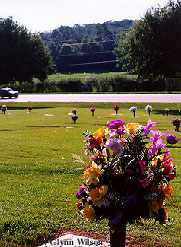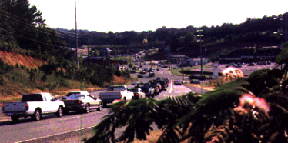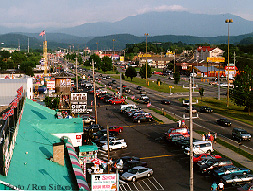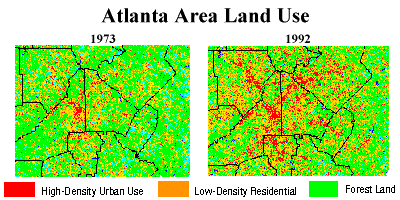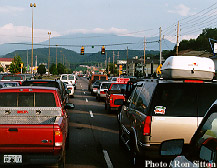 Smart Growth? The War on Sprawl Hits Center Stage
When I stand on the grassy hillside looking out over my father's gravesite, I see more than the two middle-aged oak trees, remnants of the early 20th century when the sawyers clear-cut the South from North Carolina to Texas. Across the four-lane Highway 11, I see more than a summer green field with a yellow and a red flag on the horizon, about the distance from tee-box to green on an average par-four hole on most any public golf course in America. It's not a bad view as views go from a modern suburban cemetery. No, it's not a great mountain range or a legendary river, or Augusta National for that matter. But for someone who thinks a golf course is not a bad use of land in an urban area compared to a condominium high-rise, a chemical plant, another strip mall or a Wal-Mart, well, it ain't a bad place to think about resting one's bones, if you had to. Personally, I would rather have my ashes scattered in the shallow, turquoise waters along the Gulf of Mexico. But that's another story. What I see from this still quiet hillside is a picture of what the world has been careening toward for decades, a microcosm of the future in a trend that began early in the 20th century and will become one of the most disputed issues early in the new millennium in cities across the South, America and the developing world. Very soon the developers will come in with bulldozers and cranes and build an HQ (which I suppose stands for Suburban Home Fix-It Headquarters, a warehouse retail outlet for suburban yard implements). They plan to build it right on top of the golf driving range across US Highway 11 from my family burial plot. And the only people who will protest are a few regular customers at the range, who say they plan to boycott. Right. For a month or two. Until they need a little topsoil in the wife's flowerbed, or a new wheelbarrow in which to haul it, for the cheapest price possible, all in one place. This HQ is right down the street from a Lowe's, another suburban home fix-it warehouse specializing in lamps, along with a Hampton Inn, three chain gas stations, two fast-food joints and a highway interchange. You can drive right through the interchange, after waiting for a couple of red lights and about a hundred cars to pass, and not know where in America you are. Dropped in here blindfolded from Kosovo or from down the street in Trussville, you would not have a clue you were even in the South. That's bad enough, but it's not the crucial point. In the 1950s, when the suburbs of America and the automobile age boomed, my dad took one of his pay checks from the old Southern Bell Telephone Co. and bought six burial plots in a rural area outside of Trussville, Ala., a small bedroom community to the industrial city of Birmingham. That was before the city was internationally known as Bombingham. In the '50s it was the Magic City, a boomtown born of iron ore and steel production, not an Old South city at all. Trussville is older than Birmingham, mostly built in the 1920s and '30s, when towns were more like villages, with tree-lined streets, sidewalks where children could ride bikes and skate (not roller-blade), and where new mothers could congregate and talk to the neighbors, even walk to the local store for bread, milk and tomatoes in season. It wasn't exactly a European village, or a neighborhood community like those famous in the urban areas of the Northeast. It was a little more spread-out, taking its influence from the agricultural landscape it was rapidly replacing. As recently as the 1990 census, Trussville had only 3,500 residents. At least 12,000 make their homes there now if projections for the 2000 census are even close, and that doesn't count the tens of thousands moving into the neighboring communities of Grayson Valley, Clay, and the white-flight suburb known as Center Point. According to Jane Bailey, a member of the Trussville City Council, the small town is struggling to control growth in a way that does not permanently destroy its character. The town already has tough building and zoning codes, which make it more expensive to build in town than it is in the outlying, unincorporated areas of Jefferson County. The explosion of commercial growth is new. Commercial development only accounted for 2.7 percent of the township just a few years ago. But with the opening of an industrial park and a new Interstate connector and Deerfoot Parkway, that is about to change. She feels, however, that standards in place are restrictive enough to scare away some commercial developments. Plans call for a new Wal-mart Super Center, a Goody's and a Books-A-Million just down the road in the Chalkville area, in addition to the new HQ in Trussville.
This includes narrow streets and sidewalks, in many cases missing in residential developments built around Southern cities during the past 30 years, most notably North Atlanta. But Trussville is a conservative area, largely Republican, and the idea of government limits on growth does not go down well. "We have talked about it," Bailey says. While it may not be quantitatively verifiable, the large suburb north of Trussville known as Center Point has been called one of the largest unincorporated suburbs in America, and it looks like it. Due to the lack of zoning or sign regulations, blinking neon and temporary signs almost completely obscure the landscape. There are so many messages in your face every mile it is a wonder anyone finds where they're going at all. When my family moved here it was the halfway point between the farms of Blount and St. Clair counties and the "smoky" city. In the 1960s, when racial strife swept out into the open downtown, like a sheriff's arrival at a chicken fight, whites flew northeast to Center Point and south to Hoover and Shelby County to try to protect the last remnants of white supremacist culture, with curvy streets only residents could find their way around in, and no stores in sight. I watched a second-growth forest felled completely as a kid growing up here. The other side of the story is they built a college on a good part of that ground, with a library in the heart of it. If not for that library, and the college surrounding it, I might not be writing this story today. A contradiction of modern life. We allowed the creation of the world we live in, but we don't like it in many ways. It depends on how you define "progress." The War on SprawlSince every issue has to have a name for legitimization by the media, this one's being called "Smart Growth," or "Slow Growth," or the "New Urbanism," or simply "the War on Sprawl." You know the issue has arrived when the media declares war on it. The New York Times has already stated on its editorial page that Atlanta is declaring War on Sprawl, which seems like an absurdity in the worst example of sprawling development in the South, arguably the nation. The average commute time is 31 minutes, supposedly the longest in America according to the Transportation Department, although you could get arguments from the people of L.A. Detailed Internet database searches turned up about 100 stories with these key words dating back to 1995, with a flurry in 1997, less in 1998, and an explosion in 1999. More progressive urban newspapers have headlined the issue in recent months, especially in Washington, Baltimore, Boston, Chicago and Cincinnati. They've been writing about it for years in Portland and Seattle, and to a lesser extent in Florida. Time magazine did a cover story on it in March, using as the lead illustration a computer generated graphic of an empty suburb. It's not the kind of issue that appeals to the big business Coca-Cola crowd in Atlanta or the "Big Mules" in Birmingham. And it hasn't swept the national or local television newscasts yet, but give it time.
According to a survey conducted by the National Association of Home Builders, 89 percent of people living in residential neighborhoods said they were happy with the suburban quality of life, 88 percent said they preferred to live in a single-family detached house rather than an urban townhouse, and 73 percent said growth is good "when managed properly." The survey was clearly designed, however, to justify sprawling development patterns as simply meeting the demands of a yard-hungry public. It demonstrates, says Ken Klein of the homebuilder's Smart Growth Working Group, "that development patterns are dictated by consumer preferences, not arbitrary decisions made by home builders." But that logic ignores a larger, historical pattern that guides the choices people make. "It ignores the environmental impacts and other ways suburbanites must pay, as well as the larger impacts to society," says Sam Wallace, a professor of sociology at the University of Tennessee, Knoxville and editor of Sustainable Urban Ecology, a textbook in progress. The costs include "the costs of commuting, time away from families, a host of things that impact our quality of life." The Car CultureThere is little doubt that we Americans love our cars, as long as we are careening down a multi-lane highway at or above the speed limit. That was OK in the era of Jack Burden and the Boss, when you could travel down a state road and follow the white line for miles without so much as passing another car; when the country folk would wave at everyone who passed by whether they recognized the car or not; back when the car was a new and liberating means of transportation, a mechanical way out of "Nowheresville" down Freedom of Happiness Boulevard. But as the world grows more crowded, the contradiction for modern life is that we are beginning to hate the amount of time we have to spend in our cars, getting to and from work and other routine destinations. We can go further, faster, cheaper than ever before as individuals, in the short run. But at what cost to the collective in the long run?Where most people in the South live, you now have to drive from the city to the suburbs to buy groceries. Remember neighborhood stores? Find one in the urban areas of the American South today. Mom-and-pop urban stores are similar in our culture to the old country stores some of us remember with nostalgia, but they are not quite the same in their cultural significance. Some lament their loss as a representation of the transition from agricultural to industrial life. We are way beyond that. Chain quickie marts are no substitute either. And somehow, while the Internet will inevitably affect the way we shop in the next century in a way the Home Shopping Network never really could, it will never replace being able to walk less than a city block to get your hair done, to go out for dinner, to buy a bottle of wine or a six-pack, or to attend church, without driving through a blaze of traffic and smog. Telecommuting may be a partial answer, as it was during the 1996 Olympic Games in Atlanta. Residents were brow-beaten to stay at home and work, leaving the roads in downtown Atlanta barren, while the trains and buses jammed. But in contradiction to what some analysts claim — and you can talk to them in most any city hall in America who say "people" or "the public" demand this pattern of development — the field of urban ecology and sociology shed considerable light on why our society developed the way it did. If you could talk to anyone alive early in the century and listen beyond the obvious nostalgia of yearning for a simpler age, it would become apparent that the New Urbanites of the Industrial Age moved to cities via train, and got back and forth from home to work on electric trolleys, an incredibly cheap and efficient means of transportation. Transportation Department statistics back this up. Delve into the literature on what happened to the trolleys and what you find is that the oil companies, the auto manufacturers and government officials on the national, state and local levels, all worked actively against rail transportation and brought in roads for gas-powered buses and cars. Admittedly the railroad barons were a greedy, corrupt lot. But the people did not demand the car culture. Government subsidies made it inevitable, from the road-building practices that pushed out trolley lines, to the Veteran's Administration and Federal Housing Authority loans for veterans after World War II. Policies only allowed veterans to buy houses in new suburbs. There were no subsidies to rebuild historic homes in old neighborhoods. The biggest single factor that led to sprawl may have been the Interstate Highway system, ostensibly built for the national defense. Admittedly, this era created a booming economy for much of the 1950s and '60s. But it also created the situation that led to the two major recessions in the 1970s based on the oil embargoes in 1973 and 1979. It still contributes to the air pollution crisis in our cities and mountains like the Smokies. And if not for our dependence on cheap gasoline for personal and commercial automobile transportation systems, would we have had to fight a war in the Persian Gulf to protect the world supply of oil from a raider like Saddam Hussein? These are some of the issues that are not being connected by the mainstream media in America. In large measure this is because of the instantaneous demands of filling the news slots, which do not allow time for research and reflection to connect the dots — but also because the corporate media have a huge stake in the money pool created by development. The news media love to cover the opening of another automobile manufacturing plant, especially in poor states like Alabama, with the coming of Mercedes and now Honda. Mercedes got more good ink thrown at it than Southeastern Conference football here for a while, until the governor responsible for bringing it in got replaced in office after it was fully revealed how much the tax incentives to lure the plant actually cost the taxpayers. American Dream: A Parody?Since the early 19th century, motorized transportation has influenced nearly every aspect of American society — from the economic structure to the geography of cities and the patterns of social life. Transportation accounts for about one-ninth of the U.S. economy measured in terms of gross domestic product (GDP). The economic, geographic and social factors literally determine who we are as a people on the social-psychological level. And according to critics, the results over the past century have not been positive for the environment or society. The American Dream of rugged individualism in the agrarian social structure of the 18th and 19th centuries was transformed in the wake of the Industrial Revolution into the suburbia of the 1950s and today — largely by real estate developers, the automobile, petrochemicals and related industries and their lobbies in Washington, state capitals, and cities. The American Dream became a "cruel parody," according to James Howard Kunstler, the author of Home From Nowhere."The main problem [is] that it dispensed with all the traditional connections and continuities of community life, and replaced them with little more than cars and televisions," he says. "The end product . . . was a trashy and preposterous human habitat with no future." This is the story of how the American became addicted to the automobile as the primary means of individual transportation. A large part of the story is embodied in the history of America's first major industry, the American railroads. It is a story of lost promise, a story of greed and corruption by highwaymen bent on bankrupting a cheap and efficient mode of public transport, which paved the way for the automobile to become the primary means of travel for the vast majority of Americans. In the late 19th and early 20th centuries, American cities were on the one hand communities that worked, yet on the other, growing industrial giants people longed to escape. Electric street cars were efficient and cheap modes of public transportation that carried a diverse clientele to and from work in a fashion that fostered community. By the 1940s, diesel-powered passenger trains were technological marvels, capable of carrying people from city to city at high speeds efficiently and safely. During World War II, American-made trains hauled the vast majority of troops and equipment, leading one writer in the Wilson Quarterly to the notion that trains were the decisive technology in defeating Nazism, since Hitler gutted Germany's rail system to build Autobahns. Yet streetcar ridership began a precipitous decline in 1920, and the railroads began to die as passenger carriers by 1950. Why? Was it simply that GI Joe preferred the convenience of the car? Was it the inevitable next stage in transportation history, much like the story of steam engines replacing horse-drawn stagecoaches? Was it the railroad industry's preoccupation with the profits of hauling freight? Or was there a more profound cause, a change in the ground rules for transportation that doomed the use of railroads for mass transit in the United States and drove the technology abroad to Europe and Japan? Environmental ImpactsTransportation as it is now organized generates undesirable byproducts that adversely affect environmental quality and human health. Emissions from cars, trucks and buses and the production and handling of fuels are two of the leading causes of air quality problems. Carbon dioxide (CO2) emissions from the combustion of fossil fuels are increasing the concentration of greenhouse gases, which threaten to alter the global climate. Sulfur and nitrous oxide emissions cause smog and lead to the production of ground-level ozone. Discarded motor vehicles are a significant source of solid waste. Crude oil and gasoline leaks and spills pollute water and groundwater resources.
One of the concerns has to do with the "urban heat island" effect, the principle that urban concrete and asphalt surfaces get much hotter than surfaces covered by vegetation. Why? It is directly related to an increase in the use of air conditioning, which uses a tremendous amount of energy and creates noxious emissions. The heat and emissions contribute to the increase in ozone formation, which has been linked to a number of human health problems. Not least of them is the growing problem of allergies and asthma, especially in urban children and the elderly.
Even Gore's home state of Tennessee enacted planning legislation that requires cities and counties to develop urban growth boundaries, although not much evidence exists that the policies will work unless communities take matters seriously and have proactive leadership (see student journalist comparisons of Knoxville sprawl versus Chattanooga's redevelopment, and Pigeon Forge's sprawling attitude versus Townsend's reluctance in Writer's Bloc). Plot For SaleWhile I am reluctant to argue for a conspiracy in the way we have developed our cities and neighborhoods over the past century, the facts at least reveal a concerted plot. Meanwhile, standing on the Trussville cemetery plot with my name on it, contemplating the construction of an HQ and the daily barrage of traffic and smog, my overriding thought is to run a classified ad in the local newspaper. It may remind you of an old joke about swampland for sale in Florida:"For Sale. Secluded golfview gravesite near Trussville, Ala." Think anyone's buying? 
Back to Contents Copyright © The Southerner 1999. |

